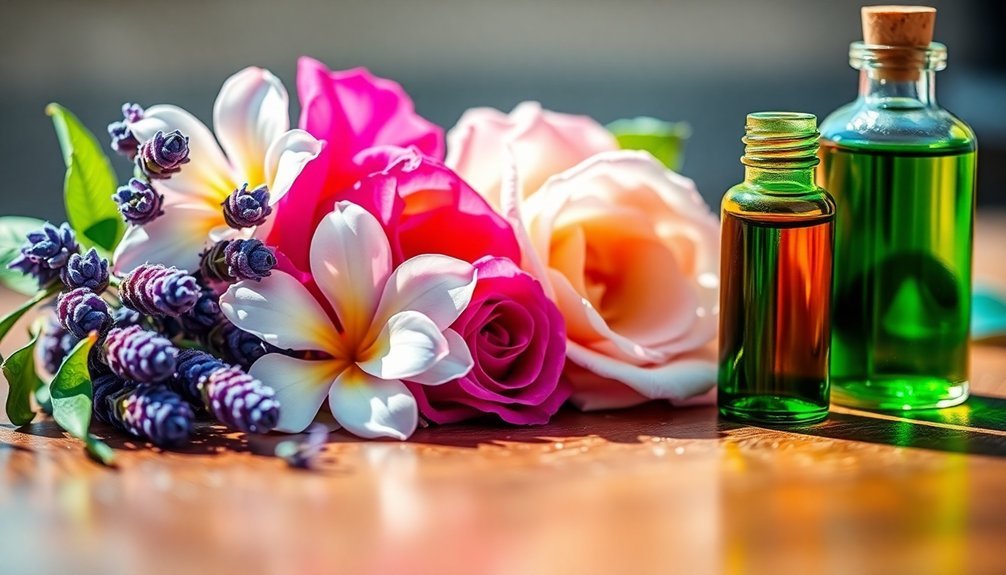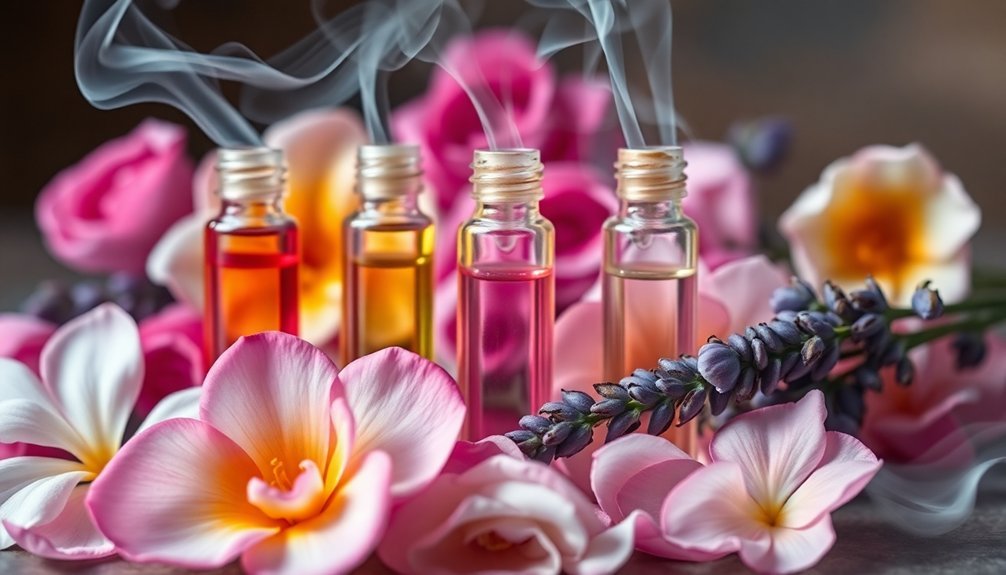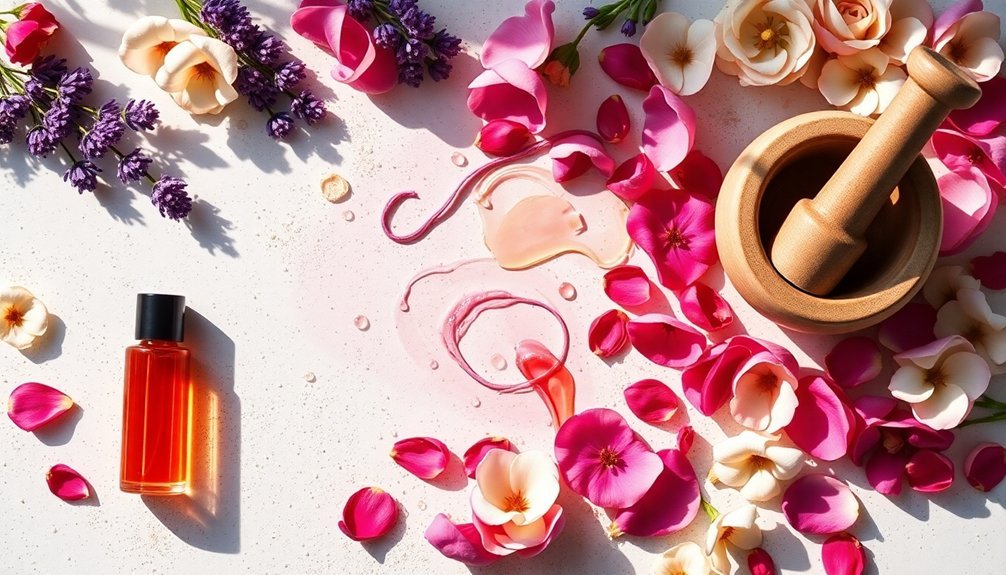To layer floral oils effectively, start with the classic 30/50/20 ratio: 30% top notes, 50% middle notes, and 20% base notes. You'll want to apply an unscented lotion first, then build your scent from lighter to heavier notes. Mix up to three different fragrances, using woody bases like sandalwood or cedarwood to anchor sweet florals. Test combinations on fragrance strips before skin application. There's an art to creating the perfect signature blend that's uniquely yours.
Understanding Base Floral Notes for Layering

While creating your own perfume blend can seem intimidating, understanding base notes is essential for achieving a well-balanced fragrance. These deep, intense notes form your perfume's foundation and guarantee its longevity, lasting for hours after application. Base notes appear as middle notes fade away, creating depth and character in the fragrance.
You'll find common base notes in woody scents like sandalwood and cedarwood, balsamic elements such as vanilla and amber, or earthy components like patchouli and musk. When you're ready to layer your perfume, start with these base notes first. They'll anchor your fragrance and support the middle and top notes you'll add later.
Base notes don't just provide staying power – they'll enhance your perfume's complexity and add warmth to your blend. Think of them as the roots that ground your fragrance, creating a rich, multifaceted experience that evolves beautifully over time.
Essential Mixing Ratios for Floral Blends
When you're mixing floral perfumes, start with the proven 30/50/20 ratio: 30% top notes, 50% middle notes, and 20% base notes.
You'll want to balance sweet floral elements with woody base notes, using roughly 1 part sandalwood or similar base note for every 4 parts of your floral components. Try creating aroma wands on separate testing strips to effectively compare and evaluate your blend combinations.
For the strongest impact, make sure your base notes support rather than overpower the florals by testing small batches on scent strips and adjusting the proportions until you achieve the perfect harmony.
Base-to-Top Mixing Proportions
Creating floral perfume blends requires three essential mixing ratios that work harmoniously with the natural progression of fragrance notes.
You'll want to start with the classic 2:1:1 ratio – two parts base notes, one part middle notes, and one part top notes. This provides a solid foundation for most floral combinations.
Alternatively, you can try the 3:5:2 ratio, which translates to 6 drops of top notes, 10 drops of middle notes, and 4 drops of base notes in a 20-drop blend. Using clean pipettes to measure each drop ensures accurate measurements for your blend.
Remember to adjust these ratios based on the strength of your specific oils.
Start by adding your base notes like Ylang Ylang or Cedarwood Atlas, then layer in middle notes such as Lavender or Rose Geranium, and finish with lighter top notes like Bergamot or Sweet Orange.
Floral Blend Strength Rules
Building on these foundational ratios, successful floral blend strengths follow specific rules that help achieve the perfect balance.
You'll want to start with a 1:1:1 ratio for basic blends, but you can adjust to 3:2:1 or 4:2:1 when working with stronger floral notes. For a 5ml bottle, divide your total drops into these proportions, leaving space for carrier oil.
When working with intense florals, you'll need to dilute them properly to prevent an overwhelming scent. Mix your fragrance oils at 20-80% concentration with carrier oils, using lower concentrations for lighter daytime perfumes.
Remember that each floral note has its own potency, so you'll need to adjust ratios accordingly. Test small batches first, and don't hesitate to modify the proportions until you achieve your desired intensity.
Balancing Sweet With Woody
The art of balancing sweet floral notes with woody base notes requires precise ratios and careful consideration of oil compatibility.
When blending, you'll want to follow the 30/50/20 rule, where woody base notes like Sandalwood or Cedarwood Atlas make up 20% of your blend, while floral middle notes comprise 50%.
For ideal results, pair Lavender with Cedarwood Atlas, or Geranium with Patchouli.
You can create a balanced blend by starting with your base notes, then layering in your middle notes.
Try mixing 2 parts Cedarwood Atlas with 3 parts Rose Geranium, or combine 3 parts Vetiver with 4 parts Palmarosa.
Let your blend mature for several days before making adjustments. This resting period allows the oils to meld together, creating a more harmonious scent.
Complementary Scents That Enhance Florals

When you're mixing essential oils for floral perfumes, you'll discover that certain pairings create more harmonious and lasting scents.
Your floral blends will come alive with citrus top notes like bergamot or lemon, while base notes of sandalwood or vetiver add depth and staying power.
Natural matches for florals include both bright fruits to enhance sweetness and oriental spices to create complexity, allowing you to craft well-rounded fragrances that evolve beautifully on the skin.
Essential Oil Pairing Secrets
Creating harmonious floral perfumes requires understanding how different essential oil families work together.
You'll find citrus oils like bergamot and sweet orange add brightness to your floral blends, while woody notes such as sandalwood and frankincense provide depth and grounding.
For classic combinations, try pairing rose with jasmine for romantic sweetness, or neroli with lavender for a fresh, soothing blend.
To enhance your floral creations, you can layer complementary herbal notes like chamomile or clary sage, which blend seamlessly with florals.
For added complexity, incorporate spicy elements such as coriander or black pepper.
When working with earthy bases, consider patchouli or vetiver to create rich, complex scents.
The key is balancing these elements without overwhelming your floral notes' delicate nature.
Natural Base Note Matches
Selecting the right base notes forms the foundation of any successful floral perfume blend. You'll find sandalwood's warm, creamy aroma creates an ideal base while extending your fragrance's longevity.
When you combine it with patchouli, you'll achieve an earthy depth that perfectly grounds floral notes.
To sweeten your blend, incorporate vanilla, which works beautifully with both florals and oriental notes while helping bind the fragrance together.
If you're seeking more complexity, add agarwood or dark spices like clove bud absolute – they'll provide a smoky, spicy dimension that prevents your blend from becoming overly sweet.
For a harmonious creation, try pairing sandalwood with vanilla and patchouli as your base. This combination will support your floral notes while adding richness and staying power to your perfume.
Step-by-Step Layering Techniques
Mastering the art of perfume layering requires three essential phases: base note application, middle note bridging, and top note finishing.
Start by applying your chosen base note sparingly to clean, moisturized skin at your pulse points. Let it dry for a few moments to establish your foundation.
Next, add your middle note, which should complement both base and top layers while adding depth to your blend. Wait for it to settle before proceeding.
Finally, apply your top note to complete your signature scent. You'll want to test small amounts first to perfect your ratio.
Don't over-apply any layer, as this can muddle the overall effect. For best results, document successful combinations and always let each layer dry completely before adding the next.
Creating Signature Floral Combinations

Now that you've mastered layering techniques, you can explore the artistry of floral combinations. Start with a dominant floral base like rose, jasmine, or tuberose, then add complementary notes to create your unique signature scent. You'll want to experiment with different pairings to discover what works best for your style.
| Base Floral | Complementary Note | Effect |
|---|---|---|
| Rose | Citrus | Fresh & Bright |
| Jasmine | Woody | Deep & Mysterious |
| Tuberose | Spicy | Rich & Exotic |
| Gardenia | Fruity | Sweet & Complex |
To create your perfect blend, apply an unscented lotion first, then layer up to three fragrances. Test your combinations on fragrance strips before applying them to your skin. Remember to start with lighter scents and build up to heavier notes for the most balanced result.
Preserving and Storing Your Floral Blends
To maximize the lifespan of your floral blends, proper storage techniques are essential.
Store your perfumes in a cool, dark place within your bedroom closet or drawer, away from direct sunlight and humidity. Don't keep them in your bathroom or near heat sources, as temperature fluctuations can damage the fragrance.
Always use dark glass bottles with tight-fitting caps to protect your blends from light and air exposure. Instead of vigorously shaking your perfumes, gently roll the bottle between your palms to mix the ingredients. This prevents unwanted air bubbles from altering the composition.
When using natural fragrances, you'll need to mix the oils before each use, but do so carefully. Remember that most perfumes last about two years, so track your creation dates and rotate your collection regularly.
Frequently Asked Questions
How Long Should I Wait Between Applying Different Floral Layers?
You'll want to wait 3-5 minutes between applying each floral layer. This gives each scent time to dry down and settle on your skin, preventing the oils from mixing unintentionally.
Can I Layer Synthetic and Natural Floral Oils Together?
Yes, you can layer synthetic and natural floral oils together. They'll actually complement each other – synthetics help extend longevity while natural oils add depth. Just apply heavier synthetic bases first, followed by lighter natural oils.
Why Do Some Floral Scents Smell Different on Different People?
Your unique genetic olfactory receptors, body chemistry, and skin oils create a personalized interaction with floral scents. That's why you'll smell fragrances differently than others, and they'll react uniquely on your skin.
Are There Specific Floral Oils That Shouldn't Be Mixed?
You'll want to avoid mixing strong florals like Ylang Ylang with Jasmine or Tuberose, as they'll compete for dominance. Instead, pair one potent floral with lighter oils for better balance.
Do Weather Conditions Affect How Floral Oil Blends Perform?
Yes, weather greatly affects your floral oil blends. You'll notice they're stronger in heat and humidity, while cold temperatures slow their release. It's best to adjust your blend's strength for different conditions.
In Summary
Now that you've learned the art of layering floral oils, you're ready to create your own signature scents. Remember to start with the proper ratios, build from base notes upward, and store your creations carefully. Don't be afraid to experiment with different combinations – your perfect blend is waiting to be discovered. With practice and patience, you'll master the delicate balance of floral perfumery.
References
- https://homecourt.co/blogs/non-toxic-body-mist/how-to-layer-perfume-oils-for-a-unique-scent
- https://shorescompany.co/blogs/all-blogs/essential-oil-blending-techniques
- https://www.vinevida.com/blogs/our-blog/layering-perfumes-with-essential-oils
- https://theperfumetreasury.com/en-us/blogs/news/the-art-of-layering-perfumes-how-to-create-a-signature-scent
- https://www.soapguild.org/tools-and-resources/resource-center/73/beginners-guide-to-fragrance-blending/
- https://demeterfragrance.com/pages/blending-basics
- https://www.lelior.com/blogs/main/understanding-fragrance-notes-top-middle-and-base-1
- https://maisondabba.com/blogs/avant-garde-perfumery-wave/a-comprehensive-guide-to-perfume-blending-for-all
- https://www.brewperfumes.com/blogs/news/perfume-101-understanding-fragrance-notes-and-families
- https://achs.edu/blog/blending-101-the-art-of-pairing/
- https://www.newdirectionsaromatics.com/blog/the-theory-practice-of-essential-oil-blending/
- https://mockingbirdapothecary.com/blogs/mockingbird-blog/crafting-perfect-scents-an-essential-oils-blending-guide-for-beginners
- https://www.immortalperfumes.com/blog/how-to-make-perfume
- https://basenotes.com/community/threads/is-there-an-order-of-operations-for-fragrance-notes-is-there-a-ratio-do-i-mix-them-seperately-or-together.532572/
- https://www.belayered.com/blogs/blog/how-to-mix-fragrance-oils-for-perfume
- https://www.luxsb.com/blog/fragrance-101-misunderstood-floral-family
- https://theherbalacademy.com/blog/how-to-create-simple-perfume-blends-using-aromatic-notes/
- https://suephillips.com/products/scent-library-perfume
- https://vitaparfum.com/blogs/news/layering-perfume-oils-guide
- https://buchartcolbert.com/collections/floral-perfume





Leave a Reply